Gluten-Free Dinner Rolls aren’t just a trendy substitute—they’re a nostalgic return to the kind of baking that brings people together around the table. Growing up, I remember sitting at my grandmother’s kitchen table as the scent of fresh-baked rolls filled the room. They were golden, warm, and slathered in butter—utter perfection. Back then, I didn’t think twice about gluten. But when my health led me to go gluten-free years later, those rolls were one of the first things I missed.
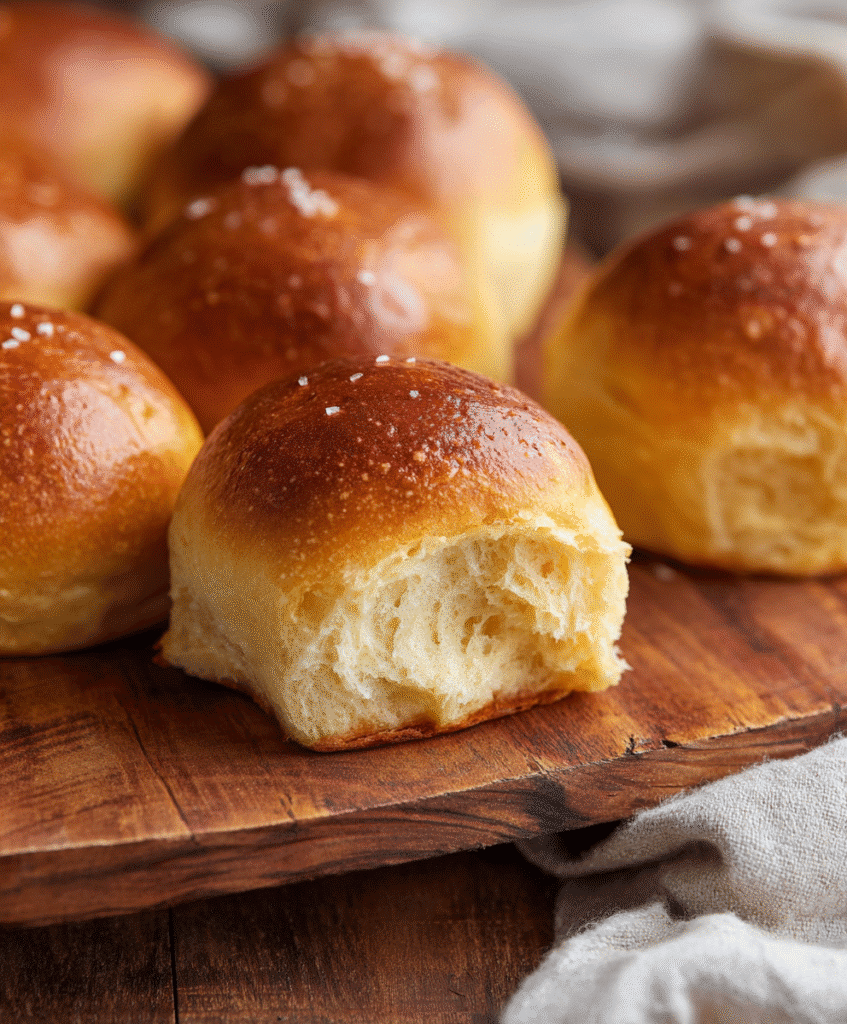
That memory lit a fire under me. I wasn’t about to settle for dry, crumbly gluten-free bread masquerading as the real thing. I wanted that same warmth, that same softness and flavor, without the gluten. And guess what? With a few tweaks, a reliable flour blend, and some patience, I recreated that magic. In this article, we’re diving deep into how you can make soft, fluffy, bakery-worthy gluten-free dinner rolls from scratch—perfect for holidays, weeknights, and everything in between.
👉 Looking for more gluten-free holiday staples? Check out How to Make a Perfect Gluten-Free Roux
Table of Contents
Table of Contents
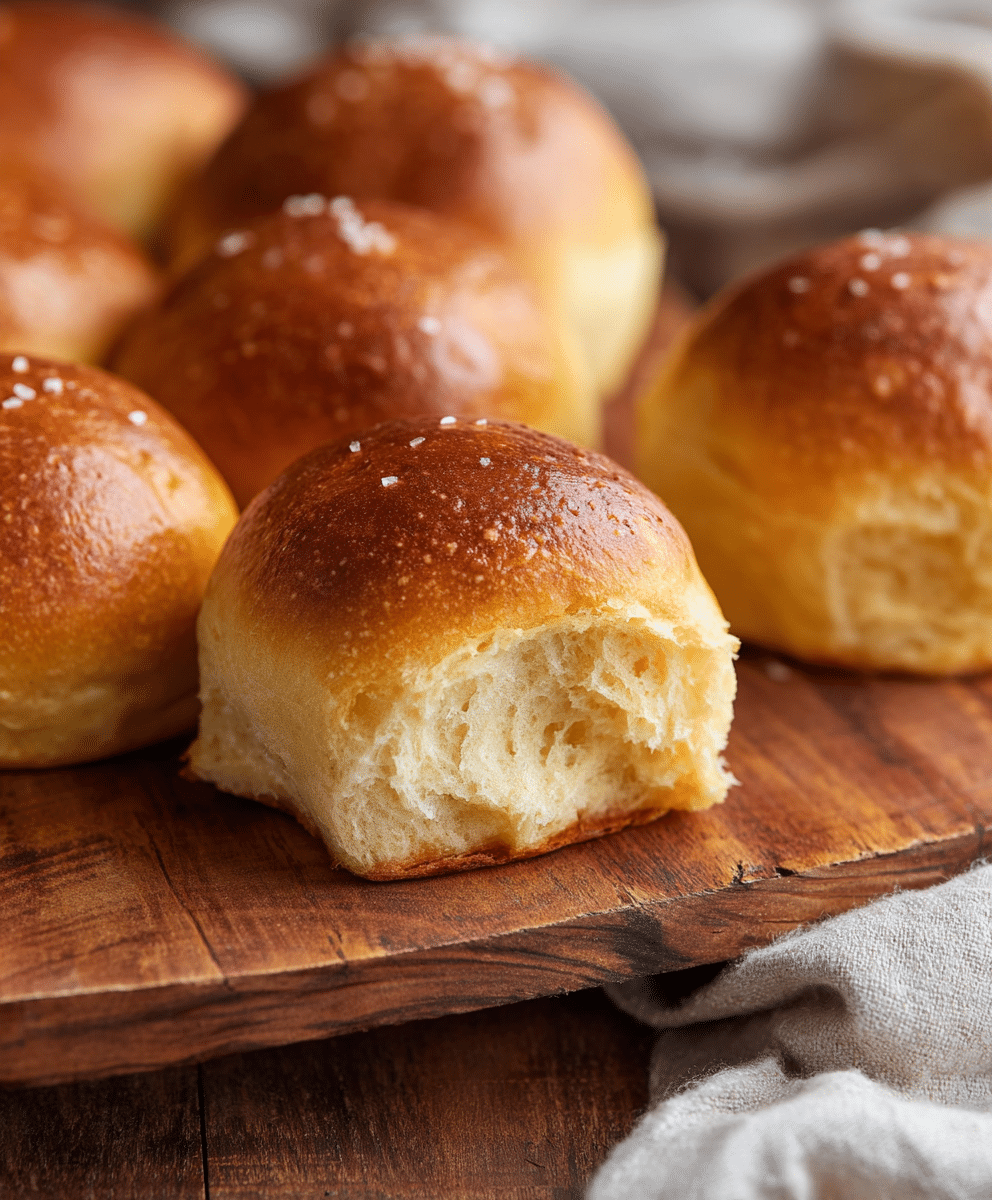
Fluffy Gluten-Free Dinner Rolls
Ingredients
Equipment
Method
- If not using instant yeast, combine yeast with warm milk and honey. Let it sit for 5–10 minutes until bubbly.
- In a large bowl, add gluten-free flour, instant yeast, salt, eggs, vinegar, melted butter, and milk. Mix until a sticky dough forms.
- Use an electric mixer with the paddle attachment and beat on medium speed for 3–4 minutes until smooth and slightly stretchy.
- Lightly oil your hands and divide the dough into 12 equal portions. Roll into balls and place in a greased 9-inch round pan.
- Cover the pan with a clean towel. Let the rolls rise in a warm place for 30–45 minutes until puffy.
- Preheat oven to 375°F (190°C). Bake rolls for 20–22 minutes or until golden brown on top.
- Allow rolls to cool slightly before serving warm with butter or jam.
Nutrition
Notes
- If your gluten-free flour blend doesn’t already include xanthan gum, make sure to add 1½ teaspoons of xanthan gum to your dry ingredients. It helps bind the rolls and makes them soft and fluffy.
- Always check your yeast’s expiration date. Even with perfect ingredients, old yeast can prevent your dough from rising properly.
- Spoon and level your flour instead of scooping. Scooping can pack too much flour into your cup and make the dough too dense. Spoon the flour into your cup, then use a knife to level it.
- These rolls work best with Pillsbury Gluten-Free Flour or other 1:1 all-purpose gluten-free blends meant for baking with yeast.
- Avoid flours like almond, coconut, or oat—they behave very differently and aren’t a good fit for this particular recipe.
- Before starting, confirm that your gluten-free flour is suitable for yeast baking. Not all blends are. Check your packaging to be sure.
Tried this recipe?
Let us know how it was!Why Gluten-Free Dinner Rolls Deserve a Spot on Every Table
What Makes Gluten-Free Rolls Different from Regular Ones
The main difference between regular and gluten-free dinner rolls is, of course, the absence of gluten. But that missing protein changes everything. Gluten gives bread its stretchy texture and helps trap air for a light rise. When you remove it, you need smart substitutions to mimic that structure.
That’s where ingredients like xanthan gum, eggs, and starches come in. Gluten-free dinner rolls rely on these to hold their shape and achieve that soft, fluffy interior. While the dough is often stickier and more delicate, the end result—if made correctly—is just as mouthwatering. Many people even say the slightly sweet, buttery flavor of homemade gluten-free rolls is better than traditional wheat-based ones.
If you’re aiming for a classic pull-apart roll experience without the gluten, this style of baking delivers it beautifully.
The Rise in Demand for Gluten-Free Baking
Gluten-free living isn’t just a trend—it’s a lifestyle. More families are dealing with gluten intolerance, celiac disease, or simply choosing to cut back for health reasons. As a result, gluten-free baking has exploded. But let’s be honest: many store-bought gluten-free dinner rolls fall flat.
That’s why baking your own gluten-free dinner rolls is such a game-changer. You get full control over the flavor, ingredients, and texture. Whether it’s Thanksgiving dinner, a Sunday roast, or a casual Tuesday night, homemade gluten-free rolls instantly elevate your table.
And once you try these soft, golden, and delicious rolls, you’ll understand exactly why they belong in your regular recipe rotation.
Ingredients That Make the Best Gluten-Free Dinner Rolls
Gluten-Free Flour Blends: What Works (And What Doesn’t)
When making gluten-free dinner rolls, your flour blend is absolutely critical. A well-balanced gluten-free flour will give structure, softness, and moisture—all the things people miss in gluten-free baking. But not every blend works well for yeast-based recipes.
The most reliable options include:
- Pillsbury Gluten-Free Flour: Best for yeast dough
- Cup4Cup Gluten-Free Flour: Great rise and flavor
- King Arthur Measure for Measure: Works well with adjustments
Avoid almond, coconut, or oat flours in this recipe—they simply don’t rise properly and will produce dense rolls. You also need to check if your blend includes xanthan gum. If it doesn’t, be sure to add 1½ teaspoons per 3 cups of flour.
Here’s a quick breakdown:
| Flour Brand | Yeast-Friendly | Contains Xanthan Gum | Best Use |
|---|---|---|---|
| Pillsbury GF Flour | ✅ Yes | ✅ Yes | Rolls, Bread |
| King Arthur Measure for Measure | ✅ Yes | ✅ Yes | Bread, Pizza |
| Bob’s Red Mill 1:1 | ❌ No | ✅ Yes | Cookies, Muffins |
| Cup4Cup | ✅ Yes | ✅ Yes | Rolls, Pizza |
| Almond/Coconut/Oat Flour | ❌ No | ❌ No | Not for Rolls |
Pro Tip: Always check the label and see if the flour says “not recommended for yeast baking.” If it does, save it for cookies—not dinner rolls.
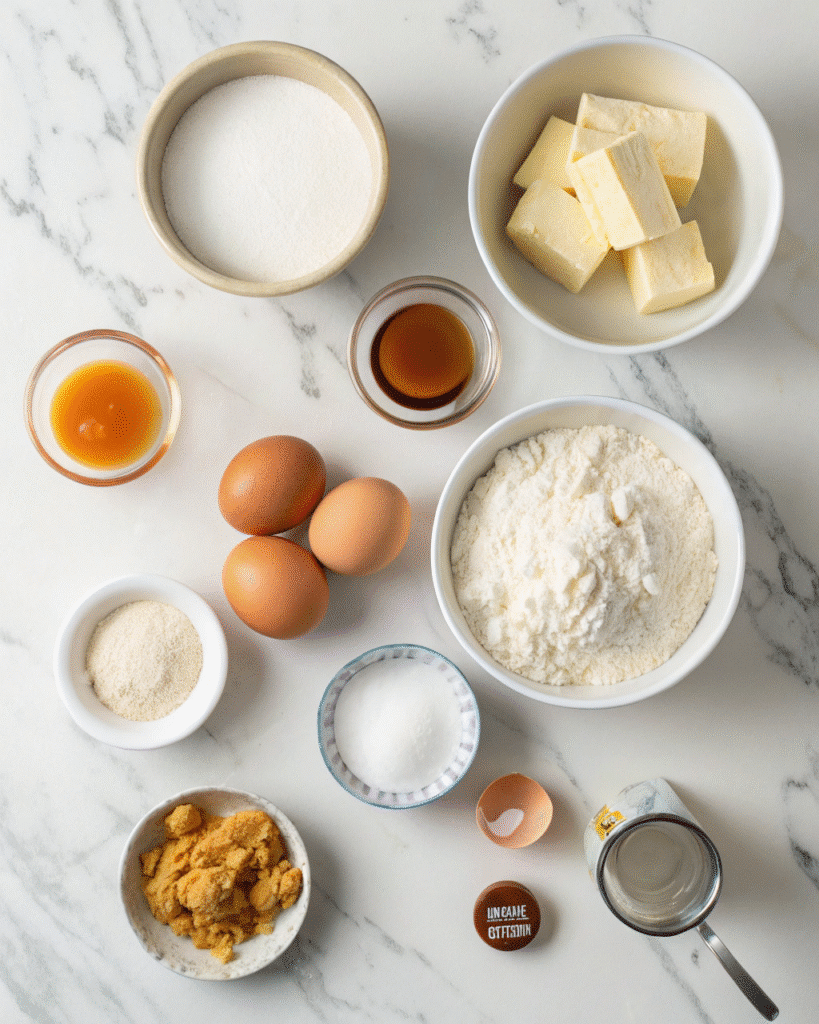
The Role of Yeast, Eggs, and Milk in Achieving Fluffy Texture
Flour might be the base, but these ingredients are the backbone of any great gluten-free dinner rolls recipe:
- Rapid-rise Yeast: No need to proof—just mix it in and let it go to work.
- Warm Milk (110°F–115°F): Activates the yeast and softens the dough. You can use almond, cashew, or coconut milk if you’re dairy-free.
- Eggs: Provide structure and richness. Use room temperature eggs for best results.
- Butter or Dairy-Free Spread: Softens the texture and adds that delicious golden top.
- Honey: Feeds the yeast and adds just the right amount of sweetness.
- Apple Cider Vinegar: Boosts the dough’s rise and softens crumb.
Together, these ingredients build a dough that’s light, pliable, and full of flavor. The result? Gluten-free dinner rolls that are pillowy, golden, and simply unforgettable.
👉 Discover great ideas like Gluten-Free Potato Salad to serve alongside your homemade rolls.
Step-by-Step Guide to Making Perfect Gluten-Free Dinner Rolls
Preparing the Dough with the Right Consistency
Making gluten-free dinner rolls might seem intimidating at first, but with the right method, it’s totally manageable—even for beginners. The dough behaves differently than traditional wheat dough, so knowing how it should look and feel is key.
Start by combining your gluten-free all-purpose flour (with xanthan gum), salt, and rapid-rise yeast in a large mixing bowl. Make a small well in the center of the flour, then pour in the yeast. This ensures even distribution and activates the yeast right where it counts.
Next, warm your milk to between 110°F and 115°F. This is crucial—too cold and the yeast won’t activate; too hot and you’ll kill it. I like to microwave the milk for about 90 seconds and check with a kitchen thermometer.
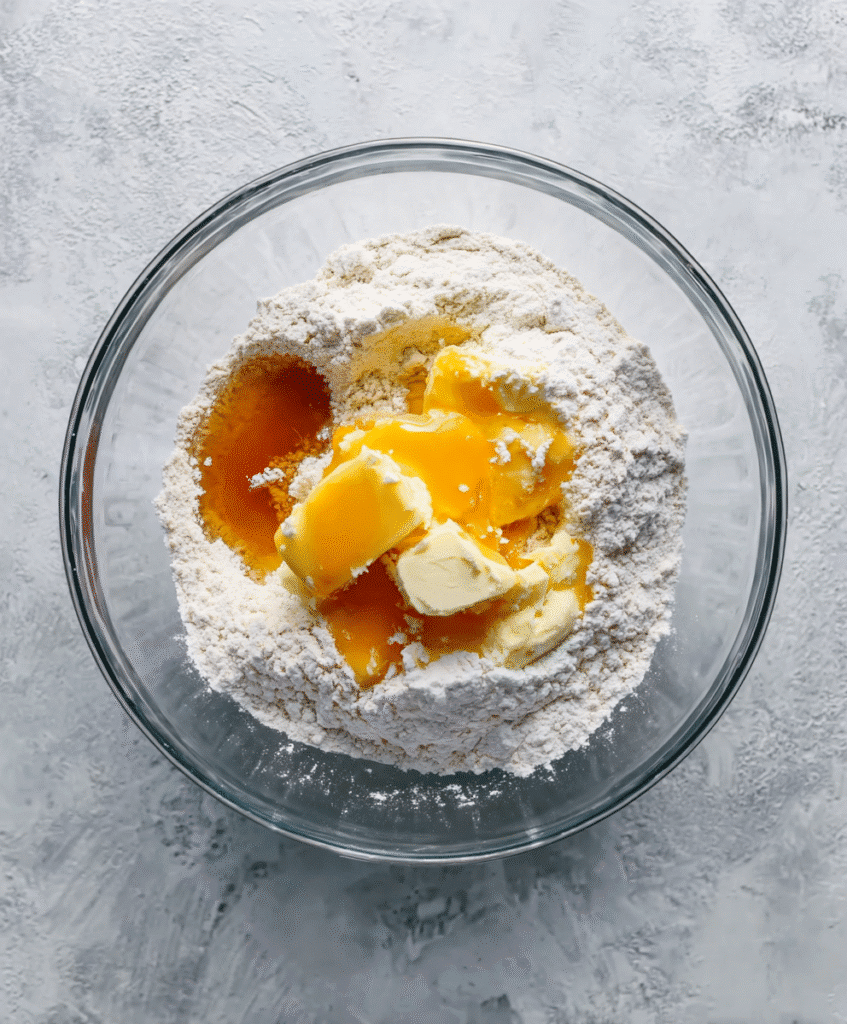
Add the milk to the bowl, followed by softened butter, eggs, apple cider vinegar, and honey. Using a stand mixer with a paddle or dough hook, mix on medium speed for 2–3 minutes. Gluten-free dough should be thick and sticky—not firm or kneadable like traditional dough. Don’t be tempted to add more flour unless it’s unworkably wet. Over-flouring will make the rolls dense and dry.
Once everything is combined, scrape down the bowl, cover loosely with a towel, and let the dough rest for 10 minutes. This brief rest helps hydrate the flour fully and improves the final texture.
Shaping, Proofing, and Baking Like a Pro
This is where the magic happens. Lightly spray two 9-inch cake pans (or pie dishes) with gluten-free cooking spray. Using a greased ice cream scoop or your hands (also greased!), divide the dough into 18 evenly sized balls.
Place 8 dough balls around the perimeter of each pan and one in the center. Smooth the tops gently with a spatula or spoon dipped in warm water or sprayed with cooking spray. This helps give the rolls that professional, rounded top.
Cover both pans with a clean kitchen towel and set them in a warm spot to rise for about an hour. If your kitchen is cool, preheat the oven to 100°F, then turn it off and let the dough rise inside.
Once the rolls have roughly doubled in size and look puffy, preheat your oven to 400°F. Bake on the center rack for 14–16 minutes. You’ll know they’re done when they turn golden brown and register 200°F internally with a thermometer.
Immediately after baking, brush the tops with melted butter or dairy-free spread. This not only adds flavor but gives the rolls their signature glossy finish.
👉 Don’t miss our Gluten-Free S’mores Bars for a cozy dessert that pairs perfectly with your dinner spread.
Quick Step-by-Step Recap
| Step | Action |
|---|---|
| 1 | Mix dry ingredients (flour, salt, yeast) |
| 2 | Add warm milk, eggs, honey, butter, vinegar |
| 3 | Mix dough until sticky and smooth |
| 4 | Scoop into greased pans and smooth tops |
| 5 | Let rise for 60 minutes in a warm place |
| 6 | Bake at 400°F for 14–16 minutes |
| 7 | Brush with melted butter and serve warm |
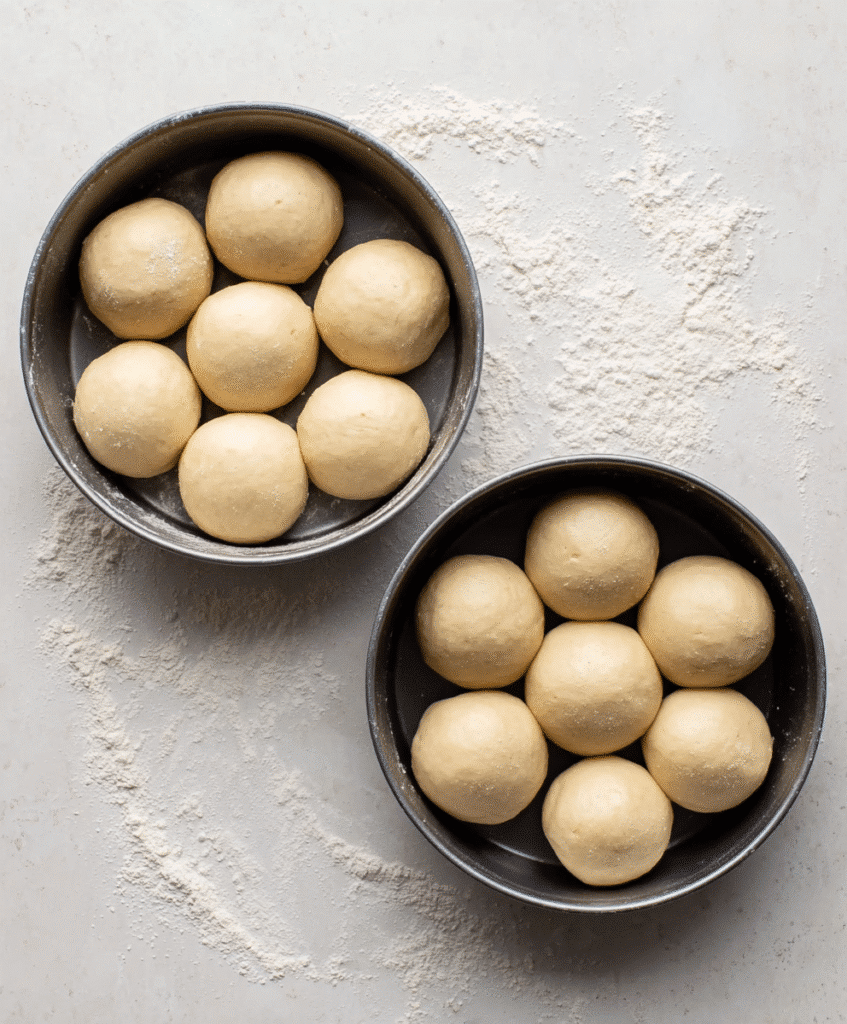
Dairy-Free & Vegan Adaptations for Gluten-Free Dinner Rolls
Making Gluten-Free Dinner Rolls Without Dairy
One of the reasons I love baking gluten-free dinner rolls from scratch is the flexibility. Whether you’re avoiding dairy or cooking for someone with allergies, these rolls adapt beautifully without losing their soft, buttery texture.
To make them dairy-free, all it takes is a few simple substitutions:
- Milk Replacement: Swap regular milk with unsweetened almond milk, cashew milk, or coconut milk. Just make sure the milk is warmed to 110°F–115°F to properly activate the yeast.
- Butter Replacement: Use a plant-based butter like Earth Balance or Smart Balance. These melt and brown just like regular butter, helping your rolls develop that soft, golden top.
- Finishing Touch: After baking, brush the tops with melted vegan butter to keep the gluten-free dinner rolls tender and flavorful.
What’s great is that these changes don’t alter the structure of the rolls. In fact, many people say they can’t even tell the difference. The texture stays fluffy, the outside gets beautifully golden, and every bite delivers that classic homemade taste—completely dairy-free.
Vegan Swaps: How to Replace Eggs in Gluten-Free Dinner Rolls
If you’re aiming for vegan gluten-free dinner rolls, you’ll need to swap out the eggs too. Eggs help bind and enrich the dough, so choosing the right egg substitute is essential to keep your rolls light and soft.
Here are the best options:
- Flaxseed Egg: Mix 1 tablespoon of ground flaxseed with 3 tablespoons of warm water. Let it sit for 5–10 minutes to form a gel-like texture. Use this for each egg in your recipe.
- Unsweetened Applesauce: Use ¼ cup of applesauce per egg. It keeps your gluten-free dinner rolls moist, though they may be slightly denser.
- Commercial Vegan Egg Replacers: Products like Ener-G or Bob’s Red Mill Egg Replacer are designed for baking and work well in yeast-based recipes.
When using egg replacements, the dough may require a slightly longer rise time. Be gentle with shaping, and don’t worry if the texture feels a bit different at first—the rolls will still bake up soft and delicious.
👉 Looking for inspiration? Try Fabulous Italian Bread Gluten-Free for more yeast-based gluten-free baking ideas.
Quick Swap Chart for Gluten-Free Dinner Rolls
| Recipe Component | Traditional Ingredient | Dairy-Free/Vegan Swap |
|---|---|---|
| Milk | Whole milk | Almond, Cashew, Coconut Milk |
| Butter | Unsalted butter | Vegan butter (Earth Balance) |
| Eggs | Large eggs | Flaxseed egg or Applesauce |
By making these easy changes, your gluten-free dinner rolls can be dairy-free, vegan, and still absolutely satisfying. Whether you’re baking for dietary restrictions or simply prefer plant-based, this version of the recipe doesn’t cut corners on taste or texture.
Common Mistakes to Avoid When Making Gluten-Free Dinner Rolls
Over-Handling the Dough
One of the biggest mistakes people make when baking gluten-free dinner rolls is treating the dough like traditional wheat dough. Gluten-free dough doesn’t need kneading—in fact, it’s better if you handle it as little as possible. Overmixing or overworking it can break down the structure you’ve built using ingredients like xanthan gum and eggs, resulting in dense or rubbery rolls.
Instead, once your ingredients are fully mixed and the dough looks smooth and sticky, stop. That sticky texture is exactly what you want. Don’t worry if it feels softer than what you’re used to. That’s normal for gluten-free dough, and it leads to the light, fluffy rolls you’re aiming for.
If you’re using a stand mixer, mix just until everything is combined. Don’t keep going to “develop gluten”—because there isn’t any to develop.
Baking Temperature & Yeast Issues to Watch Out For
The second most common pitfall? Problems with yeast and oven temperature. Your gluten-free dinner rolls need a warm, draft-free place to rise. If your kitchen is too cold, the dough won’t puff up the way it should, and your rolls will end up flat and dense.
To avoid this:
- Warm your milk to 110°F–115°F before adding it to the dough. Anything hotter than 120°F will kill the yeast.
- If needed, turn your oven on to 100°F, then switch it off and let the dough rise inside.
- Make sure your yeast is fresh. Expired yeast is one of the top reasons dough doesn’t rise.
Then there’s baking. Gluten-free rolls bake quickly—often in just 14 to 16 minutes at 400°F. But oven temperatures can vary, so it’s a good idea to check the internal temperature with a food thermometer. You’re aiming for 200°F in the center of each roll. That ensures they’re fully cooked, fluffy, and golden all the way through.
👉 Check out Gluten-Free Cherry Pie if you’re looking for another crowd-pleasing, gluten-free bake to follow your dinner rolls.
Troubleshooting Guide: Avoid These Mistakes
| Mistake | What Happens | How to Fix It |
|---|---|---|
| Overmixing the Dough | Dense, tough rolls | Mix just until combined |
| Milk Too Hot | Kills the yeast | Use a thermometer—110°F is ideal |
| Cold Kitchen | Rolls won’t rise | Proof in a warm oven (off) |
| Expired Yeast | No rise at all | Use fresh, active yeast |
| Overbaking | Dry, hard rolls | Bake until just golden, check at 14 min |
These small adjustments make a big difference in how your gluten-free dinner rolls turn out. Every detail—from yeast temperature to rise time—affects texture, flavor, and softness. With practice, you’ll be baking perfect rolls every time.
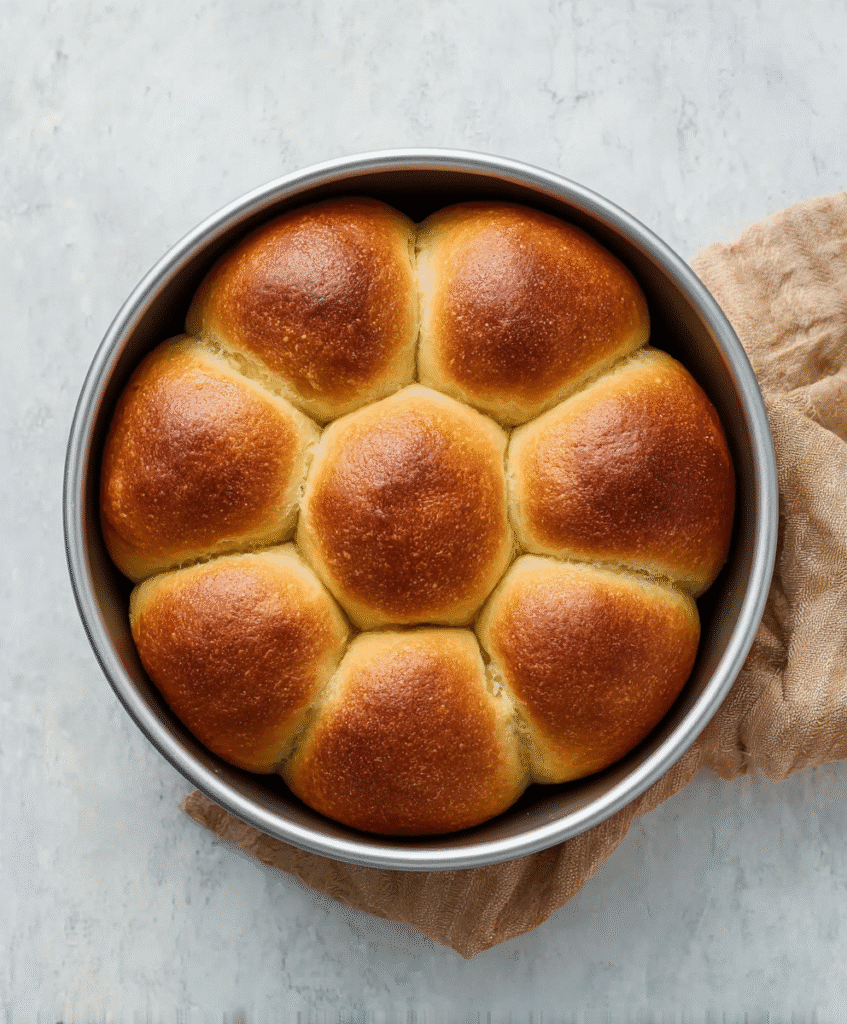
Creative Serving Ideas for Gluten-Free Rolls
Dinner Pairings: From Soups to Roasts
Gluten-free dinner rolls are one of those rare sides that go with just about anything. Whether you’re planning a holiday spread or a cozy weeknight meal, these rolls are incredibly versatile. Their soft, buttery texture and slightly sweet flavor make them the perfect partner for hearty entrees and comforting sides.
Here are some classic pairings to try:
- Soups and Stews: A warm bowl of tomato soup or chicken stew becomes even more comforting when paired with fresh-baked gluten-free dinner rolls. Use them to mop up every last spoonful.
- Roasted Meats: Whether it’s a holiday turkey, roast chicken, or glazed ham, these rolls belong on the plate. Add a pat of butter, and you’ve got a five-star side.
- Holiday Staples: Think Thanksgiving. Serve your rolls alongside mashed potatoes, green bean casserole, and gravy for a complete gluten-free holiday feast.
They’re not just filler—they’re flavor-packed, soft on the inside, and golden on the outside. And unlike many store-bought gluten-free options, these rolls actually taste like something worth remembering.
Breakfast Twists: Jam, Butter, and More
Who says gluten-free dinner rolls are just for dinner? These rolls shine at breakfast, too. Their subtle sweetness makes them ideal for morning spreads and snacks.
Try these simple breakfast transformations:
- With Jam or Jelly: Spread with homemade strawberry jam, apricot preserves, or even apple butter for a quick, comforting start to your day.
- Mini Breakfast Sandwiches: Slice them open and fill with scrambled eggs, vegan sausage, or avocado for a satisfying, gluten-free morning bite.
- Toasted with Honey: A light toasting and drizzle of honey transforms yesterday’s roll into today’s warm and sweet breakfast treat.
Kids especially love these options because they feel like a treat, but you can feel good knowing they’re gluten-free and homemade.
👉 Don’t miss our Gluten Free Ice Cream Cake for a sweet treat to follow your savory gluten-free meal.
Special Occasion Serving Ideas
Whether it’s a birthday dinner, baby shower, or holiday gathering, gluten-free dinner rolls deserve a place at the table. Dress them up by:
- Serving them in a rustic basket with a linen napkin for a warm, homemade vibe.
- Adding a butter board with flavored spreads like garlic herb butter, cinnamon honey, or vegan whipped butter.
- Baking them in mini muffin tins for cute, bite-sized rolls perfect for parties or buffets.
Their elegant simplicity means they can go rustic or refined—whatever the occasion calls for.
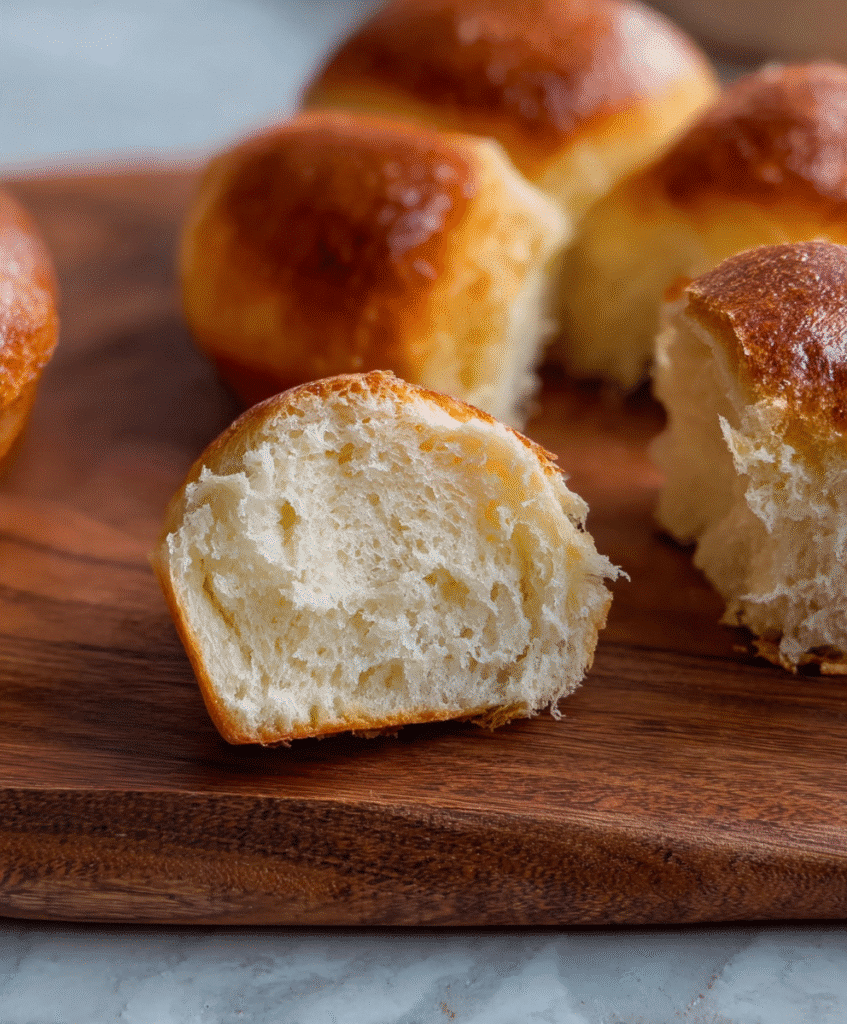
Storing & Reheating Gluten-Free Dinner Rolls the Right Way
Best Practices for Keeping Rolls Fresh
If you’ve ever made gluten-free dinner rolls before, you know they’re at their best fresh from the oven—steaming, golden, and tender inside. But what about leftovers? Don’t worry—there are reliable ways to keep your rolls soft and flavorful even days later.
Here’s how to store them properly:
- Room Temperature: Store your rolls in an airtight container for up to 3 days. Make sure they’re completely cooled before sealing to prevent moisture buildup, which can lead to a soggy texture.
- Refrigeration: While it’s not ideal for most bread, storing gluten-free rolls in the fridge can work if you plan to eat them within 24–48 hours. Wrap them in foil first, then place in a sealed bag.
- Freezing: For longer storage, freeze your gluten-free dinner rolls in a freezer-safe container. They’ll stay fresh for up to 3 months. Wrap individually in plastic wrap or foil, then place them together in a ziplock freezer bag.
Freezing is the best option if you want to make a double batch and enjoy homemade gluten-free rolls on demand.
Tips to Keep Them Soft When Reheating
Reheating gluten-free baked goods can be tricky—without gluten, they dry out faster than traditional rolls. But with the right technique, you can bring them back to life as if they were just baked.
Try these methods:
- Microwave (Quick & Easy): Wrap a roll in a damp paper towel and heat for 15–20 seconds. The steam helps restore moisture and softness.
- Oven Reheat: Preheat your oven to 350°F, place rolls on a baking sheet, and heat for 6–8 minutes. You can cover them loosely with foil to prevent over-browning.
- Steam Reheat: Use a steamer basket or a stovetop steamer setup to gently reheat without drying out.
After reheating, always brush the tops with melted butter (or vegan butter) to add shine and restore that just-baked feel.
👉 Discover great ideas like Gluten-Free S’mores Bars to pair with your rolls for a full comfort-food lineup.
Storage & Reheating Chart
| Storage Method | Duration | Reheating Method | Result |
|---|---|---|---|
| Airtight (Room Temp) | 2–3 days | Microwave or oven | Soft & warm |
| Refrigerator | 1–2 days | Oven reheat | Slightly drier |
| Freezer | Up to 3 months | Oven or steam | Fresh-baked texture |
Don’t let leftovers go to waste. With the right approach, your gluten-free dinner rolls can taste just as good on day three as they did the moment they left the oven.
Comparing Popular Gluten-Free Dinner Roll Brands
Are Pillsbury and King’s Hawaiian Gluten-Free?
When it comes to gluten-free dinner rolls, many shoppers head straight for recognizable names. But are those popular brands actually safe for a gluten-free diet? Let’s take a closer look.
Pillsbury
Pillsbury has a growing selection of gluten-free products, but unfortunately, they do not currently make gluten-free dinner rolls. Their gluten-free line includes cookie dough and pizza crust, but there’s no dinner roll option on shelves.
For anyone craving soft, pull-apart rolls without gluten, homemade remains the best (and only) solution for replicating that fresh-from-the-oven experience.
King’s Hawaiian
Here’s where many gluten-free eaters get disappointed: King’s Hawaiian does not offer gluten-free rolls. Their iconic sweet rolls are made with wheat flour and are not suitable for anyone with celiac disease or gluten sensitivity.
If you’re trying to capture that slightly sweet, pillowy texture in a gluten-free version, don’t worry. Homemade recipes—like the one we’ve walked through—deliver all the nostalgia without the gluten.
What to Expect from Whole Foods Gluten-Free Rolls
Whole Foods does offer gluten-free dinner rolls in their bakery and freezer sections, particularly under the 365 Everyday Value and Schar brands. These are convenient, certified gluten-free, and ready to heat.
Here’s a breakdown of what you get with store-bought vs homemade:
| Brand | Texture | Flavor | Price | Verdict |
|---|---|---|---|---|
| Pillsbury | Not available | N/A | N/A | ❌ Not an option |
| King’s Hawaiian | Not gluten-free | N/A | N/A | ❌ Contains gluten |
| Whole Foods (365) | Decent | Mild | $$ | ✅ Good for quick meals |
| Schar | Slightly dry | Savory | $$$ | ✅ Best when warmed properly |
While store-bought gluten-free options are improving, they still struggle to deliver the same texture and flavor as homemade. If you’re looking for that soft, golden crust and rich interior, baking your own gluten-free dinner rolls is still the gold standard.
Final Thoughts: Is Store-Bought Worth It?
Store-bought gluten-free rolls work in a pinch, but for special occasions, holidays, or anytime you want something truly satisfying, homemade is the way to go. You control the ingredients, tailor the texture, and create that warm, fresh-baked flavor that’s hard to match.
Homemade vs Store-Bought: Which Is Better?
Pros and Cons of Each
When deciding between store-bought and homemade gluten-free dinner rolls, it really comes down to your priorities: convenience or quality? While pre-made rolls can be a real time-saver, they often fall short in flavor, texture, and overall satisfaction—especially when you’re used to the soft, golden perfection of homemade.
Homemade Gluten-Free Dinner Rolls
Pros:
- Customizable for dietary needs (dairy-free, egg-free, vegan)
- Rich flavor and soft texture
- Free of preservatives and unnecessary fillers
- Perfect for holidays and gatherings
Cons:
- Takes more time and effort
- Requires proper ingredients and tools
Store-Bought Gluten-Free Dinner Rolls
Pros:
- Convenient and ready-to-eat
- Long shelf life (especially frozen options)
- Easy to find at stores like Whole Foods or online
Cons:
- Often dry or dense
- Limited options (no gluten-free versions from major brands like Pillsbury or King’s Hawaiian)
- More expensive per serving
In short: if you want control over flavor, texture, and nutrition, homemade gluten-free dinner rolls win every time. They may take a little more effort, but the payoff is well worth it.
When to Make from Scratch vs Buy Ready-Made
Let’s be honest—there’s a time for scratch baking and a time to grab what’s on the shelf. So, when should you make your gluten-free rolls from scratch?
Go homemade when:
- It’s a special occasion or holiday dinner
- You want soft, fluffy rolls that rival traditional bread
- You need dairy-free, egg-free, or vegan adjustments
- You want to impress guests with a warm, golden side dish
Go store-bought when:
- You’re short on time
- You need a quick side for a weeknight meal
- You don’t have all the baking tools or ingredients on hand
👉 Check out How to Make a Perfect Gluten-Free Roux if you’re planning to cook a full gluten-free dinner from scratch.
Final Verdict: Bake It, Don’t Buy It
There’s no question—homemade gluten-free dinner rolls deliver the flavor, freshness, and texture that store-bought rolls just can’t match. With the right ingredients and a little guidance (like the steps we’ve outlined in this article), you’ll end up with rolls that people actually remember—and request again.
So next time you’re planning a meal, skip the frozen aisle. Bake it. Your tastebuds will thank you.
Conclusion: Why You’ll Never Go Back to Regular Dinner Rolls Again
If you’ve made it this far, it’s clear you’re serious about elevating your gluten-free baking game. And honestly? Once you try homemade gluten-free dinner rolls, you’ll never look back. From the warm, buttery aroma to the tender, pull-apart texture, they offer everything you loved about traditional rolls—minus the gluten.
Whether you’re baking for the holidays, prepping for a dinner party, or just adding a little extra love to your weeknight meals, these rolls deliver. You can tweak them to be dairy-free, vegan, or freeze them for later. And unlike store-bought versions, you’ll never have to settle for “just okay” again.
So grab your mixing bowl, pick your favorite gluten-free flour, and let’s bake something unforgettable.
Follow us on Facebook & Pinterest for more gluten-free dessert ideas and community fun!
Frequently Asked Questions About Gluten-Free Dinner Rolls
What are the best gluten-free bread rolls?
The best gluten-free dinner rolls are soft, golden, and moist inside—not dry or crumbly. Homemade options using blends like Pillsbury Gluten-Free Flour or Cup4Cup deliver the best results. They allow for full flavor control and a fluffy texture that rivals traditional wheat rolls. Store-bought brands like Schar and Whole Foods 365 also offer decent pre-made options, especially when warmed before serving.
Does Pillsbury make gluten-free rolls?
Currently, Pillsbury does not make gluten-free dinner rolls. While they offer a few gluten-free products like cookie dough and pizza crust, you won’t find any gluten-free bread rolls in their lineup. If you’re craving that warm, buttery experience, your best bet is to bake your own at home.
Does King’s Hawaiian make gluten-free rolls?
No, King’s Hawaiian does not offer gluten-free rolls. Their famous sweet rolls contain wheat flour and are not safe for those with celiac disease or gluten sensitivity. To get that soft, sweet style in a gluten-free version, try making a homemade batch with a touch of honey and almond milk for a similar flavor profile.
Does Whole Foods have gluten-free dinner rolls?
Yes, Whole Foods carries gluten-free dinner rolls both in-store and online. Their 365 Everyday Value line and brands like Schar are typically found in the freezer or bakery sections. These are certified gluten-free and great in a pinch, but many people find homemade rolls offer better texture and taste.

1 thought on “The Best Gluten-Free Dinner Rolls: Soft, Fluffy & Totally Irresistible”